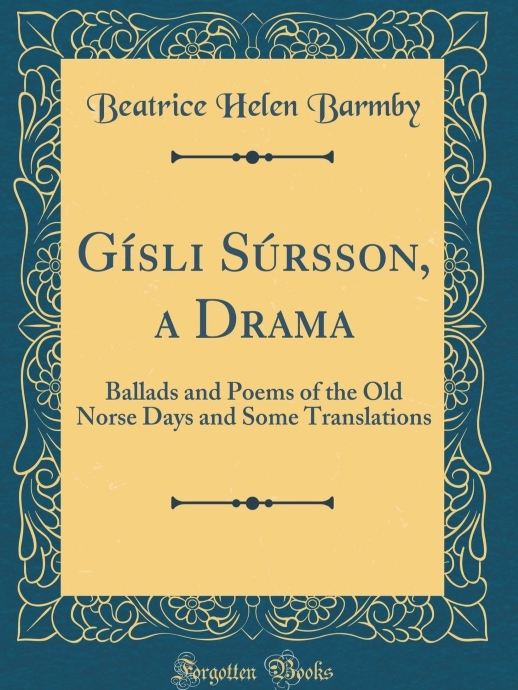Katarskytė (STK) has recently published the article “The Feminist Potential of Beatrice Helen Barmby’s Gísli Súrsson: A Drama” in the journal Scandinavistica Vilnensis.
The article looks at Gísli Súrsson: A Drama (1900) by Beatrice Helen Barmby, a play based on the Norse saga Gísla saga Súrssonar. Reading the text in light of Barmby’s biography and contemporaneous debates about gender, Katarskytė argues that it can be read as a work of feminist literature.
Victorian Vikings
Barmby’s interest in Norse sagas was not unique in the Victorian age. In the nineteenth century, many British writers drew inspiration from the Viking era. It is this Victorian fascination with medieval Norse culture, and particularly the gendered dimensions of this fascination, which is the subject of Katarskytė’s research.
The article on Barmby’s play is based on Katarskytė’s master thesis, which was submitted at the Department of Linguistics and Scandinavian Studies at UiO in 2020. She is continuing her research as a doctoral fellow at STK, with the project (Re)imagining Medieval Icelandic Femininity in Victorian Britain.

One of the reasons that the researcher, who is originally from Lithuania, has chosen this topic, is that she can identify with the curious interest that the Victorians had in the Viking age:
–I have had – and continue to have – a similar fascination, which I cannot quite explain to myself or to others. Why am I interested in Iceland? I’m not from there. Why not choose the Baltic Middle Ages, which after all would be more a part of “my” history?
But perhaps the appeal of Norse literature, both for Katarskytė and the Victorians, is the combination of the exotic and the recognizable:
–Even though much of what we find in the Old Norse sources may seem foreign, and even horrific, it's not difficult to find timeless contemplations about life, love, friendship, time, ageing, and all of the other things that people have always wondered about.
At the same time, receptions studies like Katarskytė’s project illustrate how the same literary text can be received and interpreted differently by readers in different historical contexts.
–Finding out what a Victorian writer thought about a given text influences my own readings. It’s like being in a book club with upper-class women from nineteenth century London, she explains.
"The Woman Question"
It is perhaps unlikely that many contemporary book clubs would choose Gísli Súrsson: A Drama as their book of the month. The play was never performed on stage, and Barmby herself died at the age of 30.
Even so, Katarskytė suggests that this forgotten text is relevant to the current moment. In her analysis, she demonstrates how Barmby’s adaptation of a Norse saga can be read as a response to Victorian debates on gender and marriage.
The era that Barmby lived in was dominated by the so-called “Woman Question”: the debate regarding women’s rights. These debates are fundamental both to the history of the women’s movement, as well as feminist thought.
In the article, Katarskytė draws on biographical information to say something about the writer’s possible attitude to the “Woman Question”.
Barmby’s family had ties to the women’s suffrage movement. The writer’s father, the priest Goodwyn Barmby, had views on gender that were considered radical in the Victorian era: he saw men and women as being equal.
According to Goodwyn Barmby’s writings, the ideal society was one in which both the individual and society as a whole achieved a balance between stereotypically “masculine” and “feminine” qualities.
Gender relations and marriage
Katarskytė finds similar ideas in Gísli Súrsson: A Drama.
The original saga is about Gísli, who kills his brother-in-law to avenge another murder. In her reading of Barmby, Katarskytė shows how the adaptation of the saga emphasizes the relationships between the central characters, rather than Gísli’s status as an outlaw.

Two marriages are particularly central to the play: that between Gísli and his wife Aud, and that between Gísli’s brother Thorkel and his wife Ásgerd.
Gísli and Aud have a relationship based on mutual respect and trust. Although one could argue that they have a conventional marriage with traditional gender roles, Katarskytė emphasizes Aud’s position in the story. Aud takes up nearly as much space as Gísli in the play, and she is characterized as strong, rational, and brave – qualities that were regarded as typically “masculine” at that time.
By contrast, Thorkel and Ásgerd have a more turbulent relationship. Thorkel is a jealous, controlling husband, while Ásgerd resorts to lies and manipulation. The dysfunctional dynamic between Thorkel and Ásgerd contributes to the play’s conflicts and its tragic course.
In her reading of Barmby, Katarskytė looks to two of the most influential feminist thinkers in nineteenth century Britain: Harriet Taylor Mill (1807-1858) and Mary Wollstonecraft (1759-1797).
Both Taylor Mill and Wollstonecraft argued that the oppression of women was detrimental to all of society, not just women. Marriage was particularly emphasized as an institution in which established gender roles and women’s disenfranchisement harmed the entire family.
The contrast between the two marriages in Gísli Súrsson: A Drama illustrates this point. The unhappy relationship between Thorkel and Ásgerd can be read as the result of gender norms. Thorkel is corrupted by the power he holds over his wife, while Ásgerd’s lack of agency leads her to become deceptive and untrustworthy. Meanwhile, the more equal relationship between Gísli and Aud is shown to be mutually beneficial, bringing out the best in them both.
The importance of the “ordinary”
Katarskytė emphasizes that Gísli Súrsson: A Drama isn’t a radical text that rewrites the Norse saga of Gísli as a feminist manifesto.
–I did expect that I might find something transgressive in the play when I first read it, at a time when I also happened to be reading Mary Wollstonecraft. Maybe if the play had been more radical, it might have become a literary classic, she explains.
What Katarskytė instead identifies in the text, is a more complicated mixture of feminist and conventional ideas:
–Beatrice Helen Barmby probably didn’t believe that men and women should be equal in every aspect of life. But her views – or what I read as her views, based on her play – still matter, even though the gender relations in the book might seem traditional at first glance. Just like women today, Victorian women had different ideas about gender, and different causes that they wanted to fight for.
The researcher points out that the history of feminist thought consists of more than radical, overtly transgressive texts:
–More average writers, whose legacies can‘t compare with that of Wollstonecraft, George Eliot or Christina Rossetti, had opinions on gender too.
In this vein, the article demonstrates that literary history consists of more than the unquestionable classics that remain in print year after year. Most books are eventually forgotten. Yet these texts can nonetheless tell an important story:
–At one point while I was writing my master’s thesis, I began to wonder whether it was worth it to write about a text that was so unknown and peripheral. Do we need research on literature that might be considered mediocre? But then again, maybe these more “ordinary” texts reveal the most about the societies in which they were written, Katarskytė suggests.
